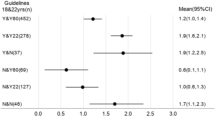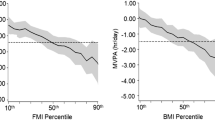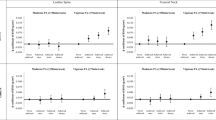Abstract
This study examined the associations of moderate-to-vigorous intensity physical activity (MVPA) trajectories in adolescence through young adulthood with adiposity in young adults. Participants from The Iowa Bone Development Study cohort were longitudinally assessed (N = 297; 57% female). Accelerometry-measured MVPA (min/day) at ages 15 through 23 years, and fat mass and visceral adipose tissue mass indices (kg/m2, g/m2) derived from dual-energy X-ray absorptiometry scans at age 23 years were analyzed. Latent trajectory analyses classified MVPA into two patterns. Multivariable linear regression analyses showed that being in the high MVPA trajectory group was associated with lower fat mass index z-scores. Individuals who were consistently active with high MVPA (vs. moderately active with decreasing MVPA) during adolescence up until early young adulthood had less accumulation of total body adiposity in young adulthood. This study suggests that adopting a consistently active lifestyle throughout adolescence can result in healthier body composition in young adulthood.

Similar content being viewed by others
References
Block, G., Woods, M., Potosky, A., & Clifford, C. (1990). Validation of a self-administered diet history questionnaire using multiple diet records. Journal of Clinical Epidemiology, 43, 1327–1335.
Brage, S., Wedderkopp, N., Franks, P. W., Andersen, L. B., & Froberg, K. (2003). Reexamination of validity and reliability of the CSA monitor in walking and running. Medicine and Science in Sports and Exercise, 35, 1447–1454.
Carson, V., Rinaldi, R., Torrance, B., Maximova, K., Ball, G., Majumdar, S., & Wozny, P. (2014). Vigorous physical activity and longitudinal associations with cardiometabolic risk factors in youth. International Journal of Obesity, 38, 16–21.
Caspersen, C. J., Pereira, M. A., & Curran, K. M. (2000). Changes in physical activity patterns in the United States, by sex and cross-sectional age. Medicine and Science in Sports and Exercise, 32, 1601–1609.
Corder, K., Sharp, S. J., Atkin, A. J., Andersen, L. B., Cardon, G., Page, A., & Janz, K. F. (2016). Age-related patterns of vigorous-intensity physical activity in youth: The International Children’s Accelerometry Database. Preventive Medicine Reports, 4, 17–22.
Craggs, C., Corder, K., Van Sluijs, E. M., & Griffin, S. J. (2011). Determinants of change in physical activity in children and adolescents: A systematic review. American Journal of Preventive Medicine, 40, 645–658.
Crouter, S. E., DellaValle, D. M., Haas, J. D., Frongillo, E. A., & Bassett, D. R. (2013). Validity of ActiGraph 2-regression model, Matthews cut-points, and NHANES cut-points for assessing free-living physical activity. Journal of Physical Activity and Health, 10, 504–514.
Crouter, S. E., Kuffel, E., Haas, J. D., Frongillo, E. A., & Bassett, D. R., Jr. (2010). A refined 2-regression model for the actigraph accelerometer. Medicine and Science in Sports and Exercise, 42, 1029.
Cullen, K. W., Watson, K., & Zakeri, I. (2008). Relative reliability and validity of the Block Kids Questionnaire among youth aged 10 to 17 years. Journal of the American Dietetic Association, 108, 862–866.
Dumith, S. C., Gigante, D. P., Domingues, M. R., & Kohl, H. W., III. (2011). Physical activity change during adolescence: A systematic review and a pooled analysis. International Journal of Epidemiology, 40, 685–698.
Ekelund, U., Luan, J., & a., Sherar, L. B., Esliger, D. W., Griew, P., Cooper, A., & Collaborators, I. C. s. A. D. . (2012). Moderate to vigorous physical activity and sedentary time and cardiometabolic risk factors in children and adolescents. JAMA, 307, 704–712.
Ellis, K. J., Abrams, S. A., & Wong, W. W. (1999). Monitoring childhood obesity: Assessment of the weight/height2 index. American Journal of Epidemiology, 150, 939–946.
Evenson, K. R., Catellier, D. J., Gill, K., Ondrak, K. S., & McMurray, R. G. (2008). Calibration of two objective measures of physical activity for children. Journal of Sports Sciences, 26, 1557–1565.
Farooq, A., Martin, A., Janssen, X., Wilson, M. G., Gibson, A. M., Hughes, A., & Reilly, J. J. (2020). Longitudinal changes in moderate-to-vigorous-intensity physical activity in children and adolescents: A systematic review and meta-analysis. Obesity Reviews, 21, e12953.
Farooq, M. A., Parkinson, K. N., Adamson, A. J., Pearce, M. S., Reilly, J. K., Hughes, A. R., & Reilly, J. J. (2018). Timing of the decline in physical activity in childhood and adolescence: Gateshead Millennium Cohort Study. British Journal of Sports Medicine, 52, 1002–1006.
Freedson, P. S., Melanson, E., & Sirard, J. (1998). Calibration of the Computer Science and Applications, Inc. accelerometer. Medicine and Science in Sports and Exercise, 30, 777–781.
Gordon-Larsen, P., Nelson, M. C., & Popkin, B. M. (2004). Longitudinal physical activity and sedentary behavior trends: Adolescence to adulthood. American Journal of Preventive Medicine, 27, 277–283.
Gordon-Larsen, P., The, N. S., & Adair, L. S. (2010). Longitudinal trends in obesity in the United States from adolescence to the third decade of life. Obesity, 18, 1801–1804.
Guo, X., Warden, B., Paeratakul, S., & Bray, G. (2004). Healthy eating index and obesity. European Journal of Clinical Nutrition, 58, 1580–1586.
Hales, C. M., Carroll, M. D., Fryar, C. D., & Ogden, C. L. (2017). Prevalence of obesity among adults and youth: United States, 2015–2016. Centers for Disease Control and Prevention (NCHS Data Brief), 288.
Hebden, L., Chey, T., & Allman-Farinelli, M. (2012). Lifestyle intervention for preventing weight gain in young adults: A systematic review and meta-analysis of RCTs. Obesity Reviews, 13, 692–710.
Hendelman, D., Miller, K., Baggett, C., Debold, E., & Freedson, P. (2000). Validity of accelerometry for the assessment of moderate intensity physical activity in the field. Medicine and Science in Sports and Exercise, 32, S442–S449.
Janz, K. F., Boros, P., Letuchy, E. M., Kwon, S., Burns, T. L., & Levy, S. M. (2017). Physical activity, not sedentary time, predicts dual-energy X-ray absorptiometry-measured adiposity age 5 to 19 years. Medicine and Science in Sports and Exercise, 49, 2071–2077.
Janz, K. F., Burns, T. L., & Levy, S. M. (2005). Tracking of activity and sedentary behaviors in childhood: The Iowa Bone Development Study. American Journal of Preventive Medicine, 29, 171–178.
Jones, B. L., & Nagin, D. S. (2007). Advances in group-based trajectory modeling and an SAS procedure for estimating them. Sociological Methods and Research, 35, 542–571.
Katzmarzyk, P. T., Barreira, T. V., Broyles, S. T., Champagne, C. M., Chaput, J.-P., Fogelholm, M., & Kurpad, A. (2015). Physical activity, sedentary time, and obesity in an international sample of children. Medicine and Science in Sports and Exercise, 47, 2062–2069.
Katzmarzyk, P. T., Denstel, K. D., Beals, K., Bolling, C., Wright, C., Crouter, S. E., & Staiano, A. E. (2016). Results from the United States of America’s 2016 report card on physical activity for children and youth. Journal of Physical Activity and Health, 13, S307–S313.
Kelly, T. L., Wilson, K. E., & Heymsfield, S. B. (2009). Dual energy X-ray absorptiometry body composition reference values from NHANES. PLoS ONE, 4, e7038.
Kwon, S., Burns, T. L., Levy, S. M., & Janz, K. F. (2013). Which contributes more to childhood adiposity-high levels of sedentarism or low levels of moderate-through-vigorous physical activity? The Iowa Bone Development Study. The Journal of Pediatrics, 162, 1169–1174.
Kwon, S., Janz, K. F., Letuchy, E. M., Burns, T. L., & Levy, S. M. (2015). Active lifestyle in childhood and adolescence prevents obesity development in young adulthood. Obesity, 23, 2462–2469.
Kwon, S., Janz, K. F., Letuchy, E. M., Burns, T. L., & Levy, S. M. (2017). Association between body mass index percentile trajectories in infancy and adiposity in childhood and early adulthood. Obesity, 25, 166–171.
Kyle, U. G., Schutz, Y., Dupertuis, Y. M., & Pichard, C. (2003). Body composition interpretation: Contributions of the fat-free mass index and the body fat mass index. Nutrition, 19, 597–604.
Lavie, C. J., Milani, R. V., Ventura, H. O., & Romero-Corral, A. (2010). Body composition and heart failure prevalence and prognosis: Getting to the fat of the matter in the “obesity paradox”. Paper presented at the mayo clinic proceedings.
Leenders, N., Nelson, T., & Sherman, W. (2003). Ability of different physical activity monitors to detect movement during treadmill walking. International Journal of Sports Medicine, 24, 43–50.
Li, K., Haynie, D., Lipsky, L., Iannotti, R. J., Pratt, C., & Simons-Morton, B. (2016). Changes in moderate-to-vigorous physical activity among older adolescents. Pediatrics, 138, e20161372.
Liu, P., Ma, F., Lou, H., & Liu, Y. (2013). The utility of fat mass index vs. body mass index and percentage of body fat in the screening of metabolic syndrome. BMC Public Health, 13, 629.
Maher, C. A., Mire, E., Harrington, D. M., Staiano, A. E., & Katzmarzyk, P. T. (2013). The independent and combined associations of physical activity and sedentary behavior with obesity in adults: NHANES 2003-06. Obesity, 21, E730–E737.
Marques, A., Minderico, C., Martins, S., Palmeira, A., Ekelund, U., & Sardinha, L. B. (2016). Cross-sectional and prospective associations between moderate to vigorous physical activity and sedentary time with adiposity in children. International Journal of Obesity, 40, 28–33.
Mitchell, J., Pate, R., España-Romero, V., O’Neill, J., Dowda, M., & Nader, P. (2013). Moderate-to-vigorous physical activity is associated with decreases in body mass index from ages 9 to 15 years. Obesity, 21, E280–E286.
Murabito, J. M., Pedley, A., Massaro, J. M., Vasan, R. S., Esliger, D., Blease, S. J., & Fox, C. S. (2015). Moderate-to-vigorous physical activity with accelerometry is associated with visceral adipose tissue in adults. Journal of the American Heart Association, 4, e001379.
Nader, P. R., Bradley, R. H., Houts, R. M., McRitchie, S. L., & O’Brien, M. (2008). Moderate-to-vigorous physical activity from ages 9 to 15 years. JAMA, 300, 295–305.
Nagin, D. S. (2005). Group-based modeling of development. London: Harvard University Press.
Nagin, D. S., & Odgers, C. L. (2010). Group-based trajectory modeling in clinical research. Annual Review of Clinical Psychology, 6, 109–138.
Nanney, M. S., Lytle, L. A., Farbakhsh, K., Moe, S. G., Linde, J. A., Gardner, J. K., & Laska, M. N. (2015). Weight and weight-related behaviors among 2-year college students. Journal of American College Health, 63, 221–229.
Nelson, M. C., Story, M., Larson, N. I., Neumark-Sztainer, D., & Lytle, L. A. (2008). Emerging adulthood and college-aged youth: An overlooked age for weight-related behavior change. Obesity, 16, 2205–2211.
Niyonkuru, C., Wagner, A. K., Ozawa, H., Amin, K., Goyal, A., & Fabio, A. (2013). Group-based trajectory analysis applications for prognostic biomarker model development in severe TBI: A practical example. Journal of Neurotrauma, 30, 938–945.
Pate, R. R., Schenkelberg, M. A., Dowda, M., & McIver, K. L. (2019). Group-based physical activity trajectories in children transitioning from elementary to high school. BMC Public Health, 19, 323.
Powell, K. E., King, A. C., Buchner, D. M., Campbell, W. W., DiPietro, L., Erickson, K. I., & Katzmarzyk, P. T. (2019). The scientific foundation for the Physical Activity Guidelines for Americans. Journal of Physical Activity and Health, 16, 1–11.
Roeder, K., Lynch, K. G., & Nagin, D. S. (1999). Modeling uncertainty in latent class membership: A case study in criminology. Journal of the American Statistical Association, 94, 766–776.
Rosito, G., Massaro, J., & Hoffmann, U. (2008). Pericardial fat, visceral abdominal fat, cardiovascular disease risk factors, and vascular calcification in a community-based sample: The Framingham heart study. Circulation, 117, 605.
Schooling, C. M., Thomas, G. N., Leung, G. M., Ho, S. Y., Janus, E. D., & Lam, T. H. (2007). Is height associated with cardiovascular risk in Chinese adults? Epidemiology, 18, 274–278.
Smith, S. R., Lovejoy, J. C., Greenway, F., Ryan, D., deJonge, L., de la Bretonne, J., & Bray, G. A. (2001). Contributions of total body fat, abdominal subcutaneous adipose tissue compartments, and visceral adipose tissue to the metabolic complications of obesity. Metabolism-Clinical and Experimental, 50, 425–435.
Togo, P., Osler, M., Sørensen, T. I., & Heitmann, B. (2001). Food intake patterns and body mass index in observational studies. International Journal of Obesity, 25, 1741–1751.
Toomey, C. M., Whittaker, J. L., Nettel-Aguirre, A., Reimer, R. A., Woodhouse, L. J., Ghali, B., & Emery, C. A. (2017). Higher fat mass is associated with a history of knee injury in youth sport. Journal of Orthopaedic and Sports Physical Therapy, 47, 80–87.
Troiano, R. P., Berrigan, D., Dodd, K. W., Masse, L. C., Tilert, T., & McDowell, M. (2008). Physical activity in the United States measured by accelerometer. Medicine and Science in Sports and Exercise, 40, 181.
VanItallie, T., Yang, M.-U., Heymsfield, S. B., Funk, R. C., & Boileau, R. A. (1990). Height-normalized indices of the body’s fat-free mass and fat mass: Potentially useful indicators of nutritional status. The American Journal of Clinical Nutrition, 52, 953–959.
Welk, G. (2002). Physical activity assessments for health-related research. New York: Human Kinetics.
Yang, X., Telama, R., Viikari, J., & Raitakari, O. T. (2006). Risk of obesity in relation to physical activity tracking from youth to adulthood. Medicine and Science in Sports and Exercise, 38, 919.
Zook, K. R., Saksvig, B. I., Wu, T. T., & Young, D. R. (2014). Physical activity trajectories and multilevel factors among adolescent girls. Journal of Adolescent Health, 54, 74–80.
Acknowledgements
We thank the study participants and staff of The Iowa Bone Development Study. We thank the study participants and staff of The Iowa Bone Development Study. This work was supported by the National Institutes of Health (R01-DE12101, R01-DE09551, M01-RR00059, UL1-RR024979, UL1-TR000442, and U54-TR001013), and research funds by the Roy J. Carver Charitable Trust and Delta Dental of Iowa Foundation.
Author information
Authors and Affiliations
Corresponding author
Ethics declarations
Conflict of interest
Minsuk Oh, Dong Zhang, Kara M. Whitaker, Elena M. Letuchy, Kathleen F. Janz, and Steven M. Levy declare that they have no conflict of interest.
Ethical approval
All procedures performed in studies involving human participants were in accordance with the ethical standards of the institutional and/or national research committee and with the 1964 Helsinki declaration and its later amendments or comparable ethical standards.
Human and animal rights and Informed Consent
All procedures followed were in accordance with ethical standards of the responsible committee on human experimentation (institutional and national) and with the Helsinki Declaration of 1975, as revised in 2000. Informed consent was obtained from all patients for being included in the study.
Additional information
Publisher's Note
Springer Nature remains neutral with regard to jurisdictional claims in published maps and institutional affiliations.
Electronic supplementary material
Below is the link to the electronic supplementary material.
Rights and permissions
About this article
Cite this article
Oh, M., Zhang, D., Whitaker, K.M. et al. Moderate-to-vigorous intensity physical activity trajectories during adolescence and young adulthood predict adiposity in young adulthood: The Iowa Bone Development Study. J Behav Med 44, 231–240 (2021). https://doi.org/10.1007/s10865-020-00190-x
Received:
Accepted:
Published:
Issue Date:
DOI: https://doi.org/10.1007/s10865-020-00190-x




